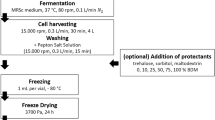Abstract
The relationship between membrane permeabilization and loss of viability by chilling depending on the chilling rate was investigated in two bacterial models: one Gram-positive bacterium, Lactobacillus plantarum, and one Gram-negative bacterium, Escherichia coli. Cells were cold shocked slowly (2°C/min) or rapidly (2,000°C/min) from physiological temperature to 0°C and maintained at this temperature for up to 1 week. Loss of membrane integrity was assessed by the uptake of the fluorescent dye propidium iodide (PI). Cell death was found to be strongly dependent on the rate of temperature downshift to 0°C. Prolonged incubation of cells after the chilling emphasized the effect of treatment on the cells, as the amount of cell death increased with the length of exposure to low temperature, particularly when cells were rapidly chilled. More than 5 and 3-log reductions in cell population were obtained with L. plantarum and E. coli after the rapid cold shock followed by 7-day storage, respectively. A correlation between cell inactivation and membrane permeabilization was demonstrated with both bacterial strains. Thus, loss of membrane integrity due to the chilling treatments was directly involved in the inactivation of vegetative bacterial cells.




Similar content being viewed by others
References
Aronsson K, Rönner U, Borch E (2005) Inactivation of Escherichia coli, Listeria innocua and Saccharomyces cerevisiae in relation to membrane permeabilization and subsequent leakage of intracellular compounds due to pulsed electric field processing. Int J Food Microbiol 99(1):19–32
Benito A, Ventoura G, Casadei M, Robinson T, Mackey B (1999) Variation in resistance of natural isolates of Escherichia coli O157 to high hydrostatic pressure, mild heat, and other stresses. Appl Environ Microbiol 65(4):1564–1569
Cao-Hoang L, Dumont F, Marechal PA, Le-Thanh M, Gervais P (2008a) Rates of chilling to 0 degrees C: implications for the survival of microorganisms and relationship with membrane fluidity modifications. Appl Microbiol Biotechnol 77(6):1379–1387
Cao-Hoang L, Marechal P, Le-Thanh M, Gervais P (2008b) Synergistic action of rapid chilling and nisin on the inactivation of Escherichia coli. Appl Microbiol Biotechnol 79(1):105–109
Clark D (2005) Molecular biology. Academic Press, Sandiego, p 784
Cleveland J, Montville TJ, Nes IF, Chikindas ML (2001) Bacteriocins: safe, natural antimicrobials for food preservation. Int J Food Microbiol 71(1):1–20
Dumont F, Marechal PA, Gervais P (2004) Cell size and water permeability as determining factors for cell viability after freezing at different cooling rates. Appl Environ Microbiol 70(1):268–272
Garcia D, Gomez N, Manas P, Raso J, Pagan R (2007) Pulsed electric fields cause bacterial envelopes permeabilization depending on the treatment intensity, the treatment medium pH and the microorganism investigated. Int J Food Microbiol 113(2):219–227
Jones PG, Inouye M (1994) The cold-shock response: a hot topic. Mol Microbiol 11(5):811–818
Kaidi S, Bernard S, Lambert P, Massip A, Dessy F, Donnay I (2001) Effect of conventional controlled-rate freezing and vitrification on morphology and metabolism of bovine blastocysts produced in vitro. Biol Reprod 65(4):1127–1134
Leslie SB, Teter SA, Crowe LM, Crowe JH (1994) Trehalose lowers membrane phase transitions in dry yeast cells. Biochim Biophys Acta 1192(1):7–13
Manas P, Mackey BM (2004) Morphological and physiological changes induced by high hydrostatic pressure in exponential- and stationary-phase cells of Escherichia coli: relationship with cell death. Appl Environ Microbiol 70(3):1545–1554
Marechal PA, Martinez de Marañon I, Porrier I, Gervais P (1999) The importance of the kinetics of application physical stresses on the viability of microorganisms: significance for minimal food processing. Trends Food Sci Tech 10:15–20
Mazur P (1970) Cryobiology: the freezing of biological systems. Science 168(934):939–949
Medrano A, Watson PF, Holt WV (2002) Importance of cooling rate and animal variability for boar sperm cryopreservation: insights from the cryomicroscope. Reproduction 123(2):315–322
Moussa M, Perrier-Cornet J-M, Gervais P (2007) Damage in Escherichia coli cells treated with a combination of high hydrostatic pressure and subzero temperature. Appl Environ Microbiol 73(20):6508–6518
Pagan R, Mackey B (2000) Relationship between membrane damage and cell death in pressure-treated Escherichia coli cells: differences between exponential- and stationary-phase cells and variation among strains. Appl Environ Microbiol 66(7):2829–2834
Pakhomov AG, Shevin R, White JA, Kolb JF, Pakhomova ON, Joshi RP, Schoenbach KH (2007) Membrane permeabilization and cell damage by ultrashort electric field shocks. Arch Biochem Biophys 465(1):109–118
Panoff J-M, Thammavongs B, Gueguen M, Boutibonnes P (1998) Cold stress responses in mesophilic bacteria. Cryobiology 36(2):75–83
Reid TJ, LaRussa VF, Esteban G, Clear M, Davies L, Shea S, Gorogias M (1999) Cooling and freezing damage platelet membrane integrity. Cryobiology 38(3):209–224
Simonin H, Beney L, Gervais P (2007) Sequence of occurring damages in yeast plasma membrane during dehydration and rehydration: mechanisms of cell death. Biochim Biophys Acta 1768(6):1600–1610
Ulmer HM, Ganzle MG, Vogel RF (2000) Effects of high pressure on survival and metabolic activity of Lactobacillus plantarum TMW1.460. Appl Environ Microbiol 66(9):3966–3973
Unal R, Kim JG, Yousef AE (2001) Inactivation of Escherichia coli O1 57:H7, Listeria monocytogenes, and Lactobacillus leichmannii by combinations of ozone and pulsed electric field. J Food Prot 64(6):777–782
Wouters PC, Bos AP, Ueckert J (2001) Membrane permeabilization in relation to inactivation kinetics of Lactobacillus species due to pulsed electric fields. Appl Environ Microbiol 67(7):3092–3101
Acknowledgments
This work was supported in part by the Agence Universitaire de la Francophonie (AUF), the Vietnamese and French Ministries of Education and Training and the Bourgogne region.
Author information
Authors and Affiliations
Corresponding author
Additional information
Communicated by Erko Stackebrandt.
Rights and permissions
About this article
Cite this article
Cao-Hoang, L., Dumont, F., Marechal, P.A. et al. Inactivation of Escherichia coli and Lactobacillus plantarum in relation to membrane permeabilization due to rapid chilling followed by cold storage. Arch Microbiol 192, 299–305 (2010). https://doi.org/10.1007/s00203-010-0555-y
Received:
Revised:
Accepted:
Published:
Issue Date:
DOI: https://doi.org/10.1007/s00203-010-0555-y




